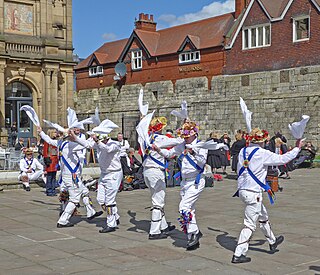
Morris dancing is a form of English folk dance. It is based on rhythmic stepping and the execution of choreographed figures by a group of dancers in costume, usually wearing bell pads on their shins and/or shoes. A band or single musician, also costumed, will accompany them. Sticks, swords, handkerchiefs, and a variety of other implements may be wielded by the dancers.

Molly dancing is a form of English Morris dance, traditionally done by out-of-work ploughboys in midwinter in the 19th century.
The folk music of England is a tradition-based music which has existed since the later medieval period. It is often contrasted with courtly, classical and later commercial music. Folk music traditionally was preserved and passed on orally within communities, but print and subsequently audio recordings have since become the primary means of transmission. The term is used to refer both to English traditional music and music composed or delivered in a traditional style.

Rapper sword is a variation of sword dance unique to Northumberland and County Durham. It emerged from the pit villages of Tyneside and Wearside, where miners first performed the tradition.
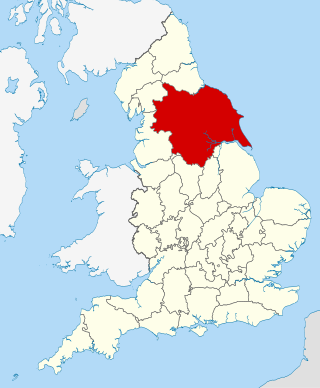
The Long Sword dance is a hilt-and-point sword dance recorded mainly in Yorkshire, England. The dances are usually performed around Christmas time and were believed to derive from a rite performed to enable a fruitful harvest.

Eliza Amy Forbes Carthy, MBE is an English folk musician known for both singing and playing the fiddle. She is the daughter of English folk musicians Martin Carthy and Norma Waterson.
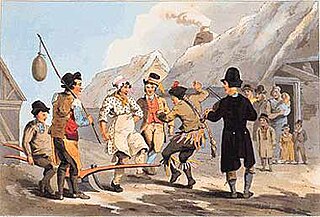
Plough Monday is the traditional start of the English agricultural year. While local practices may vary, Plough Monday is generally the first Monday after Epiphany, 6 January. References to Plough Monday date back to the late 15th century. The day before Plough Monday is referred to as Plough Sunday, in which a ploughshare is brought into the local Christian church with prayers for the blessing of human labour, tools, as well as the land.

Folk plays such as Hoodening, Guising, Mummers Play and Soul Caking are generally verse sketches performed in countryside pubs in European countries, private houses or the open air, at set times of the year such as the Winter or Summer solstices or Christmas and New Year. Many have long traditions, although they are frequently updated to retain their relevance for contemporary audiences.
There has been a folk festival in the coastal town of Sidmouth in South West England in the first week of August every year since 1955, attracting tens of thousands of visitors to over 700 diverse events.
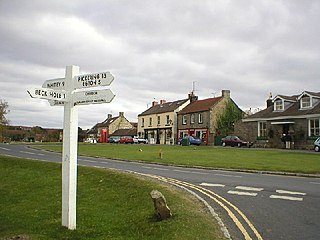
Goathland is a village and civil parish in the Scarborough district of North Yorkshire, England. Historically part of the North Riding of Yorkshire, it is in the North York Moors national park due north of Pickering, off the A169 to Whitby. It has a station on the steam-operated North Yorkshire Moors Railway line.
Janet Heatley Blunt (1859–1950) was a British folklorist.
The English Folk Dance and Song Society is an organisation that promotes English folk music and folk dance. EFDSS was formed in 1932 when two organisations merged: the Folk-Song Society and the English Folk Dance Society. The EFDSS, a member-based organisation, was incorporated in 1935 and became a registered charity in 1963.
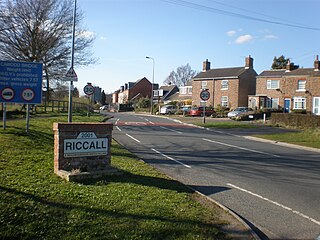
Riccall is a village and civil parish in North Yorkshire, England, lying 3.5 miles (6 km) to the north of Selby and 9 miles (14 km) south of York. Riccall is noted for being the place where Harold Hardrada's force of invaders landed in 1066, just before the Battle of Stamford Bridge. In the Second World War, an RAF base was built north of the village, and between the late 1970s and the early 2000s, coal was mined from beneath the village as Riccall Mine, part of the Selby Coalfield.
Maud Karpeles OBE, was a British collector of folksongs and dance teacher.

A Mighty River of Song was a unique concert performance by various members of the Waterson family on 12 May 2007 at the Royal Albert Hall in the South Kensington area of London, England.

Stave dancing is a style of folk dance from the south-west of England, especially Somerset, Dorset, and Wiltshire. Teams of dancers carry long decorated poles, known as staves, over their shoulders whilst performing. Having effectively died-out in the 1920s, interest in the style revived in the 1980s, and today a number of Morris and country dancing teams perpetuate the tradition. Some claim the tradition's origins lie in the annual ‘club-walks’ of the friendly societies.
Dancing England was a series of showcase traditional dance concerts held at the Derby Assembly Rooms from 1979 to 1987. They were devised and curated by Phil Heaton and John Shaw, members of the Black Cap Sword Dancers, and two very notable characters on the Nottingham and Derby folk and dance scene of the 1970s. Dancing England was set up to showcase the best of traditional dance in the UK, along with unique and/or interesting folk customs to celebrate the UK's wide cultural heritage.
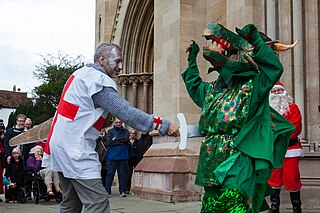
Mummers' plays are folk plays performed by troupes of amateur actors, traditionally all male, known as mummers or guisers. Historically, mummers' plays consisted of informal groups of costumed community members that visited from house to house on various holidays. Today the term refers especially to a play in which a number of characters are called on stage, two of whom engage in a combat, the loser being revived by a doctor character. This play is sometimes found associated with a sword dance though both also exist in Britain independently.
David "Doc" Rowe is a folklorist, author and film-maker who lives and works in the United Kingdom. A graduate of Hornsey College of Arts, he is a prominent lecturer on and advocate for folk traditions and folk music.

Beckhole Incline was a steep, rope-worked gradient on the railway line between Whitby and Pickering, in the North Riding of Yorkshire, England. Opened in May 1836 as part of the horse-worked Whitby & Pickering Railway, the line was operated by three railway companies before becoming redundant on the opening of a diversionary line to the east that allowed through working by steam engines on the entire line. Although the incline was closed to regular traffic in 1865, it was used for a very brief period in 1872, to test a special locomotive intended for railways with steep gradients.













